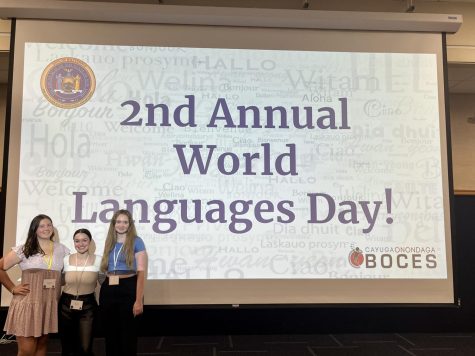A Hundred Years Forgotten: The Armenian Genocide
May 4, 2015
April 24th marked the one hundred year anniversary of the start of the Armenian Genocide, the systematic killing of an estimated 1.5 million Armenians by the Ottoman Empire (present day Turkey). On that day, 250 Armenian doctors, lawyers, teachers, and priests were arrested and subsequently deported. Red Sunday, as it was called, began the plight of the Armenians, who still languish from repercussions to this day. But compared to the Holocaust, or even the Rwandan Genocide, the Armenians’ suffering is little-known in this day and age. In fact, the United States does not recognize Armenian Genocide as an example of genocide. Of the 193 United Nations member states, only 26 recognize the genocide on a national level. Even nations that have suffered genocide in their own borders, like Bosnia-Herzegovina or Cambodia, don’t officially recognize the Armenian people’s tragic history. The answer to why most nations don’t recognize Armenian Genocide is a complex geopolitical situation, and even though it’s a century old, it still affects international relations to this day.
Armenia herself has a storied and rich history. The Kingdom of Armenia (331 BC–428 AD) was the first state to adopt Christianity as a state religion in 301 AD. Ancient Armenia stretched from the Caucasus Mountains to the Sinai Peninsula at its greatest extent. Following both Arab and Byzantine rule, Armenia eventually found itself under Ottoman rule by 1453. While the Ottomans were an Islamic state, they allowed “people of the book” (Jews and Christians) to worship freely if they paid a jizya tax, reserved for non-Muslim citizens. This also exempted them from military service and gave their respective societies autonomy. Following centuries of foreign rule, the Armenians, alongside the Kurdish people (who are predominantly Sunni Muslim), found themselves concentrated in Eastern Anatolia. By the 1800s, the Eastern provinces of the Ottoman Empire were experiencing a nationalistic thirst. In 1839, Sultan Mahmud II introduced the Tanzimat reforms, a series of reforms designed to simmer down nationalistic fervor and instill a sense of “Ottomanism” amongst minorities of the Empire. The reforms were largely unsuccessful, and by the 1870s, the so-called “Armenian Question” was being discussed by great European powers like Britain and France.
Long the “sick man of Europe”, the Ottoman Empire began to decline by the 18th Century. By the 1900s, the Ottoman Empire’s days were severely numbered. In 1908, the Young Turk Revolution occurred, which led to the absolute monarchy of the Sultanate being deposed and a multi-party system be put into place. Throughout this time period, various Armenian armed insurrections occurred, but these had little clout on the dream of Armenian sovereignty. By 1914, however, the Committee of Union and Progress (CUP), a Young Turk-associated movement, grew suspicious of the Armenians. World War I had broken out, and the Young Turks felt the Armenians would create trouble against the Empire by siding with the Allied Powers (the Ottomans were in an alliance with Germany and Austria-Hungary, who were fighting against Britain, France, and Russia). Many young Armenian men joined the Russian army, as the Armenian people traditionally had cordial relations with the Russians, with both sharing a common religion (Orthodox Christianity) and disdain towards the Ottomans. Fearing an Allied-back uprising, the CUP ordered the arrest of the 250 Armenian intellectuals on April 24th, 1915. On the 27th of May, the Ottoman Parliament passed the Tehcir Law, the bill that issued the deportation of the Armenian population. A tragedy was born.
News of the mass deportations found itself travelling rapidly throughout the world. The West was appalled by the event, and even the Ottomans’ wartime allies privately acknowledged the brutality of the killings. Teddy Roosevelt expressed the Armenian Genocide as “the greatest crime of the war”. The news was unable to keep up with the actual speed of the murder. Armenians (as well as Greek and Assyrian Christians), of all walks of life, marched towards the Syrian Desert and their certain death. Those who hadn’t died of starvation during the death march found themselves in the town of Deir-ez-Zor, located alongside the Euphrates River in Syria. The starving Armenians ate grass, as it was their only food in weeks. Several methods were used to exterminate the surviving Armenians: mass burnings and drowning being two of the more common ways. Forced in caves, the Armenians would be burnt alive. If the fire itself didn’t kill them, the smoke inhalation certainly did. North, in the Black Sea, women and children were put on barges and carried out to deep water. They were then cast overboard and left to drown.
There’s no official consensus on how many Armenians died during the genocide. Unlike the Nazis, the Ottomans did not keep records concerning the deported Armenians. Most historians agree that 500,000 Armenians died at the minimum, but it’s commonly accepted that 800,000 to 1,500,000 perished. According to documents that once belonged to Talaat Pasha, one of the main perpetrators of the genocide, 970,000 Armenians died in 1915 alone. Historian Ara Sarafian places the 1914 Armenian population at 1,700,000 and the 1917 population at 284,157. Massacres against Armenians still continued until 1919.
In 1923, the Republic of Turkey was established, and by 1924 the Ottoman sultanate was abolished. The Ottoman Empire, arguably once the greatest empire on the Earth, was no more. The majority of surviving Armenians fled to western countries, such as the US, Russia, and Canada. Many more migrated to the Middle East, and settled in the Levant and Persia. To this day, the Armenian diaspora is the largest of its kind. There are more people of Armenian descent living abroad than in Armenia itself. In 1922, Armenia was established as a Soviet Socialist Republic, or a region of the USSR. By the late 1980s, the Armenians, like many other ethnic groups under Soviet rule, demanded sovereignty. On September 21st, 1991, Armenia was officially established as a sovereign nation, breaking away from Soviet rule. Unfortunately, new troubles were beginning.
Nagorno-Karabakh is a landlocked region in southwestern Azerbaijan, Armenia’s eastern neighbor. Nagorno-Karabakh, or Artsakh, is made up of ethnic Armenian Christians. Azerbaijan is a predominantly Shia Muslim country who has close diplomatic and ethnic ties with Turkey. In the late 1980s, the people of Nagorno-Karabakh held a referendum to join the Armenian SSR. The Azeris, as well as the Soviet government in Moscow, found the referendum illegal, as the Karabakh region makes up approximately 15% of Azerbaijan. Bloody fighting, as well as purported genocide committed by the Armenians against Azeri civilians in Khojaly, went on for six years until a ceasefire was signed in 1994. An estimated 30,000 people were killed. Following the ceasefire agreement, both Turkey and Azerbaijan closed their borders with Armenia, which remained locked to this day. Because of this, Armenia has allied itself with Russia and Iran, who both have subpar relations with Turkey and Azerbaijan. Conflict in Nagorno-Karabakh (who now operate as a self-declared republic, unrecognized by the United Nations), still continues intermittently to this day. In 2014, 61 people were killed in the conflict. 25 people have been killed this year alone.
The Turkish government still disputes the Armenian Genocide. Article 301 was put into place in 2005, making it a crime to “insult Turkishness”, which includes attributing the Ottomans to genocide. According to them, forced relocation/displacement does not fall under ethnic cleansing. To explain the deaths of over a million people, the Turkish attribute the deaths to accidental starvation (even though the Ottoman Turks knowingly withheld food from the Armenians during the death marches) and attacks by Kurdish bandits. The Turkish government denies Armenian Genocide for several reasons:
There are no official government documents that call for mass killings of Armenians, only deportation.
World War I deemed the deportation as necessary, because Armenian rebels undermined national security.
The Ottoman Empire is viewed with great pride in present-day Turkey. To recognize that genocide occurred would be a great insult to the Turkish people and their ancestors.
The current Turkish government would have to pay reparations to the families and their descendants that suffered during the genocide.
The majority of the international community shares similar sentiments regarding if the plight of the Armenians was genocidal or not. Though 43 states (including New York) recognize the events of 1915 as genocide, the federal government does not. As a senator, Barack Obama promised to recognize Armenian Genocide if elected president. He has not done so, and it’s unlikely he will. Turkey, a NATO member, is the bridge between the West and Middle East. During the Cold War, when many Middle Eastern states aligned themselves with the USSR, Turkey was allied with the US. To this day, the United States still operates at an air base in Turkey, which is vital regarding the current situation in Iraq and Syria. If the US recognizes that the Ottoman Turks carried out such atrocities, it’s very likely that American-Turkish relations will diminish rapidly. Israel, a nation whose founding was solidified because of the Holocaust, does not believe that Turkey is responsible for committing genocide. During the Nagorno-Karabakh War, Israel provided armament support to Azerbaijan. This proves almost ironic, as the Azeris were receiving combatant support from Islamic militants such as Hezb-e-Islami, a group that supports the eradication of Israel. Many Armenians who live in Israel are faced with discrimination regarding land rights.
Only 26 UN states consider the massacres against the Armenians as genocide. The newest states to adopt that position include Germany, Bulgaria, and Syria. Many regional governments around the globe recognize the genocide as well. Governor Andrew Cuomo recently signed a bill acknowledging April 24th as Armenian Remembrance Day. But compared to the Holocaust, why is the Armenian Genocide touched upon so little in our history curriculum? When asked, Mr. Lobello gave his position. “The sheer numbers definitely play a part. 12 million people, six million of them Jews, were killed. World War II received much more media attention, especially with firsthand video and photographic accounts. The bodies of those slaughtered at death camps were caught on film. Compared to the Armenians, who lived in remote Eastern Turkey before the widespread use of video, the Holocaust was projected into Western minds much easier.”
The events of a hundred years ago coincide with contemporary pop culture as well. Kim and Khloe Kardashian, along with Kanye West, recently visited the memorial to the genocide in Yerevan, Armenia. The Kardashian family are Armenians who fled prior to the massacres in 1915. In Los Angeles, 130,000 marched Friday in memory of the dead. All Lebanese schools were closed to honor the dead. Sadly, it’s unlikely the US will honor those who died any day soon. But as every year passes, we hopefully get closer to remembering the Armenians who have been forgotten for these past hundred years.










